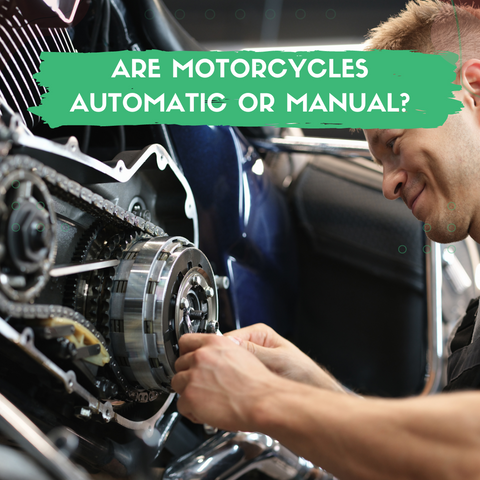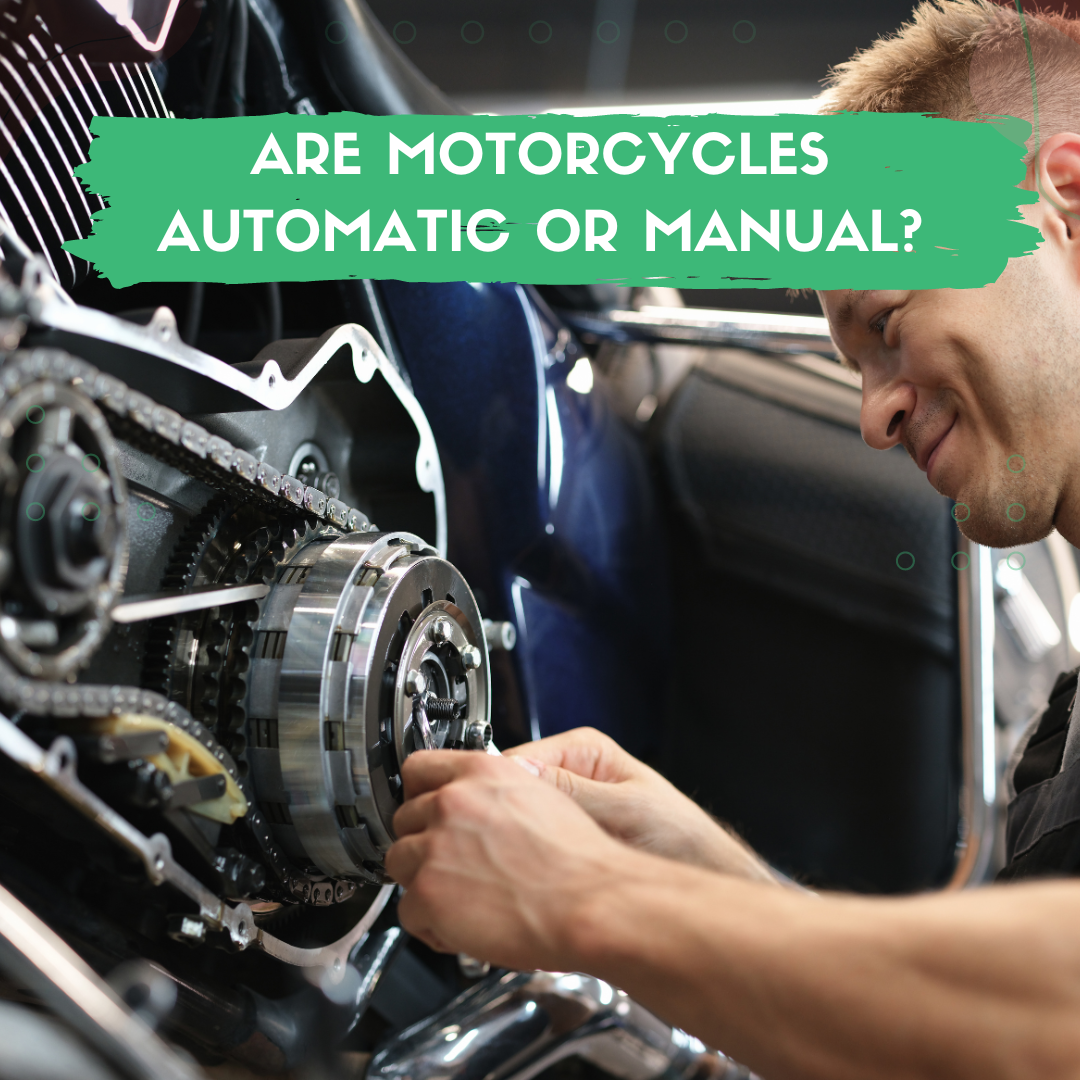When it comes to motorcycles, there's more than just the style, size, and colour to consider.
One critical aspect that often stirs a debate among riders is the type of transmission: automatic or manual. 
But what exactly do these terms mean, and what are the pros and cons of each?
This comprehensive guide is here to answer these questions and help you make an informed decision about your next motorcycle purchase.
The Short Answer to "Are Motorcycles Automatic Or Manual?"
Motorcycles can be either automatic or manual. The motorcycle market features a variety of models with both types of transmissions. While manual motorcycles, offering greater control and acceleration, have long been a staple in the industry, automatic motorcycles are gaining popularity. They offer easier handling, particularly in heavy traffic, by automatically managing gear shifting. Both manual and automatic motorcycles have their unique benefits, catering to different rider preferences and experiences.
Understanding Motorcycle Transmissions
Motorcycle transmissions play a vital role in determining how a bike is ridden and the overall riding experience.
Two main types of transmissions dominate the motorcycle market today: manual and automatic.
Related: Do Motorcycles Have Automatic Transmissions?
The Rise of Automatic Motorcycles
Automatic motorcycles, although not as prevalent as their manual counterparts, have seen an increase in popularity over the years.
They're particularly favoured in city environments and heavy traffic, where the stop-start nature of commuting is less hassle without the need for frequent gear changes.
The automatic system prevents the bike from stalling by shifting gears automatically, a feature that beginners and less confident riders might find appealing. However, this convenience comes at a cost—automatic motorcycles typically weigh more, use more fuel, and come with a heftier price tag.
Related: Are Go Karts Automatic Or Manual?
The Traditional Appeal of Manual Motorcycles
On the other hand, manual motorcycles have long been the standard in the industry.
Riding a manual bike offers a certain thrill and sense of control that's difficult to replicate with an automatic transmission.
Shifting gears manually provides the rider with a more engaging ride, demanding greater attention and effort.
The acceleration of manual bikes is generally more efficient, adding an extra punch of excitement to the ride. However, the learning curve is steeper, requiring riders to master the balance between clutch use and gear shifting.
If you're interested in learning about kids motorcycles, I recommend clicking on this link.
Examples of Automatic and Manual Motorcycles
When it comes to automatic motorcycles, some notable models that have garnered attention include the Honda NC750X DCT and the Aprilia Mana 850.
These models embody the convenience and ease of an automatic transmission, ideal for beginners or city riders.
In the realm of manual motorcycles, the likes of the Triumph Bonneville T120 or the Yamaha MT-07 stand out.
These motorcycles offer manual enthusiasts the thrill and control they seek, alongside the timeless appeal of manual transmissions.
Please remember that the availability of these models may vary based on your location and the current market trends.
Related: Are Dirt Bikes Automatic?

Trends in the Motorcycle Industry
Historically, the motorcycle industry has been dominated by manual transmissions, seen as the traditional choice for their control and hands-on riding experience. However, with technological advancements and changing rider needs, automatic motorcycles are steadily carving their niche in the industry.
Many manufacturers are recognising the benefits of automatic motorcycles and are developing models that incorporate this technology.
The increasing popularity of automatic transmissions can be seen in urban environments, where convenience and ease of use are paramount.
In terms of future trends, it's likely that we'll continue to see growth in the automatic motorcycle sector, especially as electric motorcycles, which usually have automatic transmissions, become more widespread. However, the love for manual motorcycles isn't disappearing anytime soon, with a solid base of enthusiasts appreciating the control and engagement they offer.
If you want to know the history of kids riding motorbikes and how it has evolved over time, take a look at this link.
The Differences: Automatic vs Manual Motorcycles
Ease of Use
For beginner riders or those looking for an effortless ride, automatic motorcycles are easier.
An automatic motorcycle takes care of all the gear changing and clutch work for you, providing a more relaxed riding experience.
On the contrary, manual transmissions require greater rider interaction and coordination between the throttle, clutch, and gears.
Acceleration and Performance
If acceleration and speed are your top priorities, then manual motorcycles have the edge.
Their efficient transmission system allows for faster response and mobility, giving the rider the thrill of full control over the bike's performance.
Automatic bikes, while offering smooth acceleration, can't quite match the sharpness and responsiveness of manual transmissions.
Cost Considerations
When it comes to costs, manual bikes are generally cheaper to purchase and maintain.
Their simpler mechanical setup results in lower maintenance costs and better fuel efficiency.
Automatic motorcycles, while offering greater convenience, tend to have higher upfront costs, fuel consumption, and maintenance expenses.
Learning Curve: Automatic vs Manual Motorcycles
The learning process and experience of a rider play crucial roles in choosing between automatic and manual motorcycles.
For novice riders, automatic motorcycles could present an easier learning curve.
The absence of clutch and gear-shifting operations allows beginners to focus on balancing the motorcycle and understanding road rules without worrying about gear changes.
Conversely, manual motorcycles demand a higher level of skill.
Riders need to master clutch control, gear shifting, and the right timing of these operations in synchrony with their speed and road conditions.
While this could initially pose a challenge, it ultimately leads to a more engaging and rewarding riding experience.
However, the 'right' choice varies from person to person, depending on their comfort level, the effort they're willing to put into learning, and the kind of riding experience they seek.
Related: 5 Mind-Blowing Facts About Dirt Bike Gears: You Won't Believe

Making the Choice: Automatic or Manual?
Choosing between an automatic and a manual motorcycle depends on personal preference, riding style, and experience.
If you're starting out or prefer a more laid-back ride, an automatic might be the easier route. However, if you love the thrill of controlling your bike's acceleration and don't mind the extra effort, a manual bike could offer an exhilarating ride that automatic bikes may not replicate.
In Summary
In the article, we delve into the differences, pros, and cons of automatic and manual motorcycles, the two main types of transmissions dominating the motorcycle market.
The rise of automatic motorcycles is highlighted, emphasising their ease of use in city environments and for beginners due to their gear-shifting automation. However, their higher weight, fuel consumption, and cost are recognised as potential downsides.
The article also discusses the traditional allure of manual motorcycles, noting their longer-standing presence in the industry.
Manual motorcycles offer riders a thrilling and engaging experience, providing better acceleration and efficiency. However, they require a greater learning effort, mastering the clutch use and gear shifting.
Specific motorcycle models with both transmission types are highlighted, offering real-world examples for readers.
Industry trends and the learning process for both types of transmissions are explored as well, showing that while automatic motorcycles continue to gain popularity, especially in urban settings, manual motorcycles maintain a firm base of enthusiasts who relish the control and engagement they provide.
The choice between an automatic or manual motorcycle largely depends on the rider's personal preference, experience, and desired riding experience, proving that both types of transmissions have their unique place in the motorcycle world.







Share:
Can You Drive Electric Go Karts On The Road in 2025?
Can You Buy A Motorcycle Without A License in 2025?